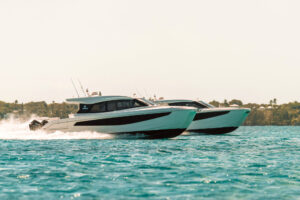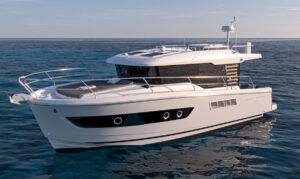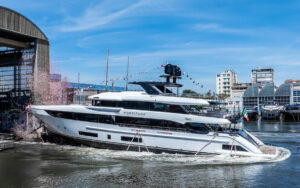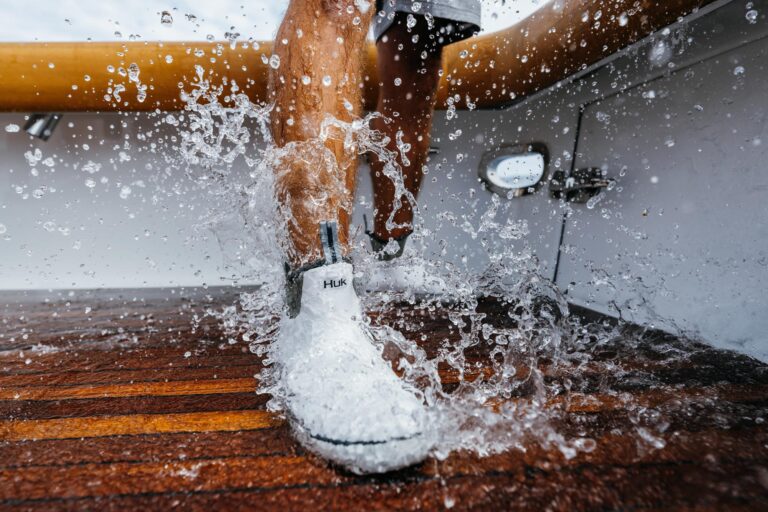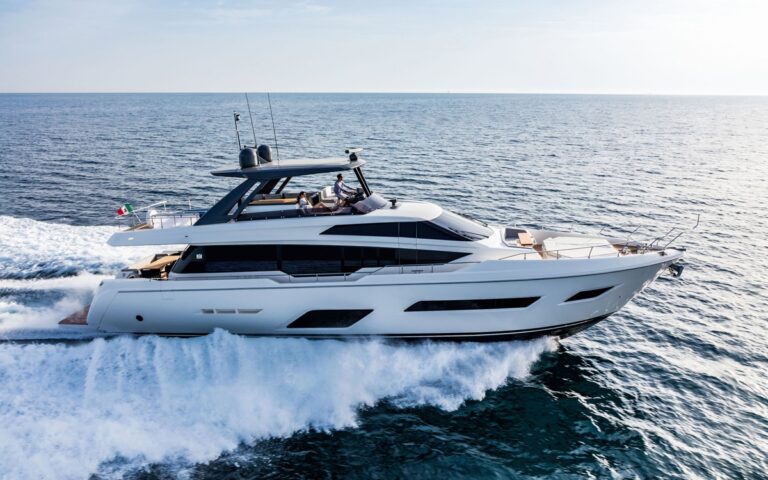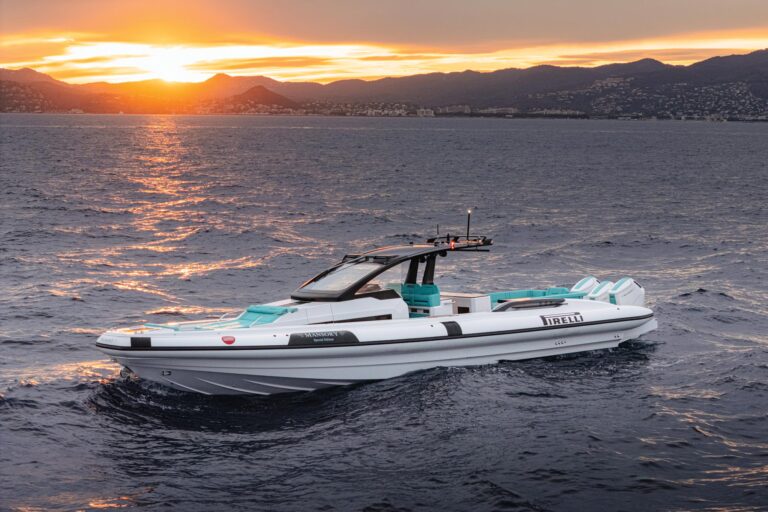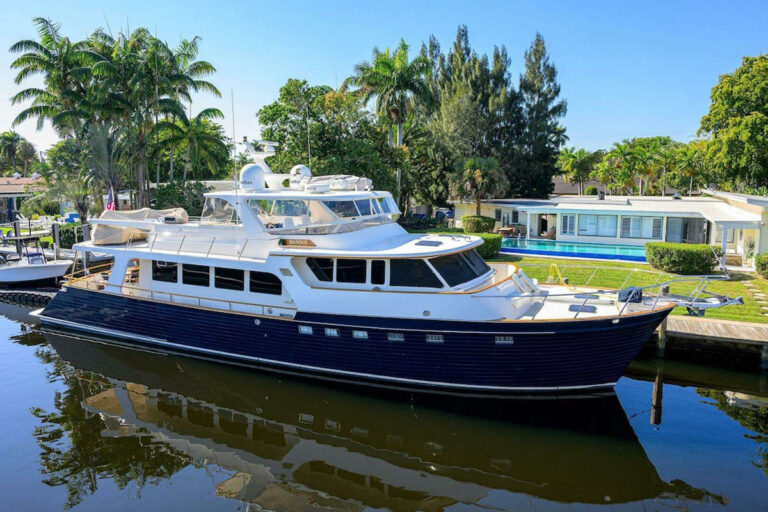The driver’s eyes ballooned in amazement as I pitched half-packed bags from the tired J/44’s cockpit into the water taxi’s belly, my windburned face and salt-stiffened skin hinting at the trauma of the previous several days. When I ran out of bags, I pitched soggy foul weather gear and the occasional lone flip-flop. There was no conversation that April day in Antigua, only grunts and sighs. Bad weather, a leaky boat, a busted engine, a cracked mast, marginal delivery sails and faulty systems had plagued the entire trip from St. Thomas. Now, at the start of Antigua Sailing Week, I wanted nothing more than to be firmly planted on land with a cold beer in hand.
One week later, on a hard drive off Miami, the Ron Holland-designed Opus 73 Volare made that hell a distant memory. Sure, there is a sizable difference between a J/44 (still one of my favorite boats) and this New Zealand beauty, but my love for sailing has evolved to the civilized excitement the Opus 73 offers. Her design and construction took me back to the special sailing experiences that captured me from the time I was 6, and overcame all that had turned me into a lunatic in Antigua the week before.
Volare is the second Opus 73 launched. The first, Golden Opus, is Holland’s personal yacht and is in transit from the South Pacific to Ft. Lauderdale. Holland and Opus Yachts drafted a challenging design brief for Volare, and seem to have met every point. Two important goals for the yacht were handling ability without full-time crew, and systems and sail-handling simplicity. Allan Foot of Opus Yachts sailed Volare single-handed for more than 1,200 miles, from Anguilla to Miami, proving not only that he is a formidable sailor, but that the yacht’s design and systems make shorthanded sailing a real possibility.
The in-boom furling system allows for a fully battened mainsail to be carried, providing better shape than a conventional furling mast system. A carbon-fiber boom is fitted with a hydraulic mandrel roller furling unit, and a few easy tricks ensure an easy hoist. The system can be manually overridden, and if the hydraulics fail while the sail is up, the halyard can be dropped to bring the sail down. Anyone who has been flogged aloft while trying to drop a jammed mainsail on an in-mast furling system will appreciate the Leisure Furl system. A Reckman furling system takes care of the foresail and provides additional ease of handling.
“It’s a great boat for any owner-operator who likes to work his own boat,” said Volare’s captain, Martin Smith.
A single jib sheet leads from the clew to a track, then aft to a three-speed Lewmar Hydraulic 66 winch starboard of the wheel. All it takes to tack Volare is a turn of the wheel or a 90-degree adjustment on the autopilot. Thanks to the deep spade rudder, she turns on a dime.
Volare is sailed from her after helm cockpit. Flanking the helm are the jib winch, main sheet winch, panel for the vang and backstay adjustment, and controls for the main and foresail furling systems. A sheltered cockpit is forward of the helm cockpit, keeping guests away from the mechanicals and providing a nice setup for alfresco dining. This arrangement is also appealing for charter, but is flexible: Holland has a single, commodious center cockpit on Golden Opus.
The wide, uncluttered teak decks are a function of the 18-foot, 3-inch beam. Deck fills are recessed into the cabin house, and scuppers drain at the waterline, keeping the navy blue hull streak-free. The waist-high lifeline and stanchions allow safe, secure transit to the foredeck in heavy weather.
Wind was light and variable during our sea trial, but as you would expect from a Ron Holland design, Volare was a great sailor. We maintained 6.4 knots over the ground with 11.1 knots of true wind on the beam, and achieved 7.6 knots working the headers in 13.9 knots of true wind. If the wind moves abaft the beam, go with the MPS for added performance in light air. She is a fun boat to sail, a nice juxtaposition of nimble and solid.
Ease of handling also translates into docking on the Opus 73. Granted, Capt. Smith has earned his stripes bashing around the southern oceans in tall ships, but he maneuvered Volare like an Austin Mini by using the retractable bow thruster.
Her hull is a sandwich of closed-cell PVC core and composite skins. Vinylester resin and stitched, bidirectional, E-type fiberglass fabric is combined with an outer laminate to create a thickness of about 3.5 mm on the hull sides. Thickness increases to about 4.6 mm on the bottom. Kevlar is used selectively in the forward bottom sections. The inner laminate is constructed with biaxial and triaxial reinforcements to an approximate thickness of 2.6 mm. Two full-length longitudinal stringers, an intermediate partial-length stringer, and structural bulkheads and soles act as stiffeners. To reduce weight without compromising strength, bulkheads are constructed with composites. About 29,600 pounds of lead provides the external ballast.
The venerable Sensation yard in New Zealand built Volare, and Andrew Winch and Holland designed her interior. Her layout is a nice compromise between a proper seagoing vessel and a comfortable home, and she has the ambience of a much larger yacht.
Her pilothouse, for example, feels like that aboard the ex-Shanakee, a 108-foot Holland design built by Palmer Johnson. A U-shape settee is large enough to seat eight, the same number accommodated by Volare’s berths. Autopilot and a Micro-commander engine control forward at the chart table let the captain pilot Volare from below. In front of the settee is a plasma TV, which a switch lowers away when not in use. Two overhead hatches provide more light and ventilation in the saloon.
Stowage in the galley rivals that of a small warehouse. A full-height pantry is on the port side, and overhead cabinets are above the counter. I’m not wild about a straight galley on an ocean-going yacht such as Volare, which could benefit from a U-shape area under sail. However, such a galley would not be as user-friendly in port. As a compromise, I would install a stainless-steel bar around the stove and counter, allowing the cook to strap himself in, at least on a starboard tack.
The design brief requires providing a comfortable boat for two couples. The guest cabin includes a double berth, hanging locker and head; and there are two equal-size cabins forward with over-and-unders. A shared head and forepeak are forward.
Abaft the saloon is a utility room. This is another chart area that doubles as the owner’s study and access to the engineroom, where the 185 hp Perkins is easily serviced from all sides. By contrast, Golden Opus was outfitted with a Lugger.
Volare’s master stateroom is wonderfully packaged in a contrast of light fabrics, white hull ceiling and warm cherry. This cabin will make a nice retreat, whether the sun is burning the skies on the equator or rain is driving down in the Pacific Northwest. A tapered island berth is on centerline, and a large head is forward with a separate shower stall. (The word “stall” doesn’t seem appropriate for Volare; “shower room” works better.)
One added bonus absent from the design brief is the value of building a yacht such as Volare in New Zealand. Because of the strong dollar, owners can expect to pay a little more than $3 million for a new build. Considering the pedigree of Holland and the quality of the build, that level of value will be tough to beat. In addition, Opus is working on larger builds.
Contact: Opus Yachts, (011) 64 96 34 6993; [email protected]; www.opusyachts.com.

